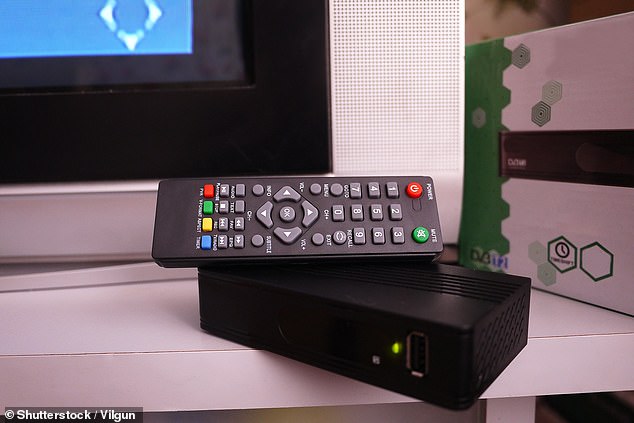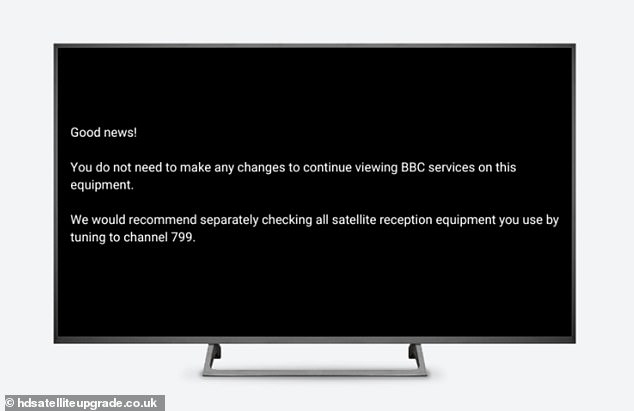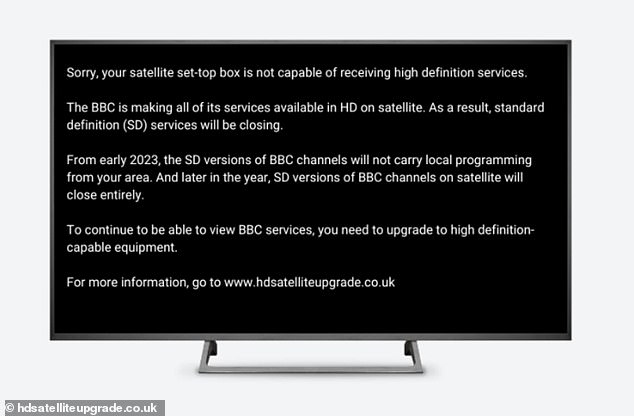Thousands of Britons will lose access to BBC channels – find out if you’ll be affected
>
A huge upgrade means thousands of British satellite viewers will lose access to their BBC channels – unless they buy a new set-top box.
From this week, BBC is replacing its standard definition (SD) feeds on satellite with high definition (HD) versions, starting with BBC One.
Satellite customers in the south of England are getting the update first, followed by the rest of the country throughout January and February.
Here’s how to make sure you won’t lose your BBC channels when it takes effect.
A massive upgrade to BBC programming means some satellite viewers may lose access to channels (file
Those affected will start to lose BBC One in January or February, but in early 2024 they could lose all BBC channels when the change is completed.
It was last November that the BBC announced the change, but the public broadcaster is rolling it out from this week.
‘We’ll be upgrading all BBC channels to HD on satellite,’ the BBC said in a statement.
‘Unfortunately, to roll regional versions of BBC One HD in England on satellite plans, we need to close the standard definition (or SD) versions of our channels on the digital satellite platform.
‘This is not a decision that’s been taken lightly – indeed, it’s been one of the key reasons why we’ve held back so long in our HD rollout plans.’
Satellite channels are broadcast from a TV station on Earth to satellites orbiting above us in space.
The signals are then returned to Earth and received by your satellite dish.
Until now, satellite viewers in London, as an example, have had to switch to channel 101 to get BBC One in SD, and go to channel 106 for BBC One in HD. (These satellite channel numbers vary depending on region.)
Unfortunately, local variations of BBC One (e.g. BBC One London, BBC One South) haven’t been in HD.
Therefore, if satellite viewers have been watching BBC One in HD on channel 106 at 6:30pm, they’ve had to switch to SD on channel 101 to get their local news bulletin.
With the change, channel 101 will now be in HD, so they won’t have to do this any longer, while channel 106 will become more or less defunct for the time being.

To be able to access free TV via satellite you will require a satellite dish and a satellite receiver, usually a separate set top box (pictured)
BBC One South, BBC One Northern Ireland and BBC Two Northern Ireland make the change this week, while BBC One East and BBC One East Midlands will follow next week, followed by more regions in February.
BBC One London doesn’t make the switch until the week starting February 13.
Whether you’re affected depends on what satellite platform you’re using – Sky or Freesat.
For those on Freesat, go to channel 799 on your satellite TV to see if you have a compatible receiver.
If you see a ‘Good news!’ message, this means you’re ready and won’t be affected, so you don’t need to do anything.
It also means that over the next few months, your new HD BBC One region will appear on channel 101 automatically.
However, if you see a message saying ‘sorry, your satellite set-top box is not capable of receiving high definition services’, these changes will affect you.
If so, you’ll need to upgrade your Freesat set-top box to a HD device, which are sold on Freesat’s website and by several high street retailers.

This message means you’re not impacted by the switchover and are ready to get your version of BBC One in HD in early 2023

If you see this message it means you are going to be impacted by the BBC’s changes to its SD and HD channels
Meanwhile, for those using the Sky platform, the easiest way to check is to go to channel number 105.
If you see ‘Channel 5 HD’, there’s nothing else you need to do, but if you see ‘Channel 5’ without HD at the end then you’ll be impacted and need to upgrade.
The BBC and Freesat have launched a dedicated website to support people with SD-only satellite boxes to move to a high-definition (HD) device.
Sky also has a list of affected SD-only set-top boxes on its website, including ‘4F2001 to 4F2006 (Amstrad)’ and ‘0F01 to 0F05 (Panasonic)’.
